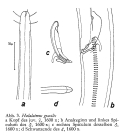WoRMS taxon details
Halalaimus gerlachi Keppner, 1992
584302 (urn:lsid:marinespecies.org:taxname:584302)
accepted
Species
marine
Gerlach, S. A. (1967). Freilebende Meeres-Nematoden von den Sarso-Inseln (Rotes Meer). <em>Meteor-Forschungsergebnisse (D).</em> 2:19-43.
page(s): 21-22; note: Described as Halalaimus gracilis, but renamed by Keppner, 1992 as Halalaimus gerlachi [details] Available for editors [request]
[request]
page(s): 21-22; note: Described as Halalaimus gracilis, but renamed by Keppner, 1992 as Halalaimus gerlachi [details] Available for editors
Type locality contained in Red Sea
type locality contained in Red Sea [details]
Taxonomic remark Halalaimus gerlachi n. sp. Synonym: Halalaimus gracilis sensu Gerlach, 1967; пес H . gracilis De Man, 1888.
Gerlach (1967)...
Gerlach (1967)...
Taxonomic remark Halalaimus gerlachi n. sp. Synonym: Halalaimus gracilis sensu Gerlach, 1967; пес H . gracilis De Man, 1888.
Gerlach (1967) described specimens of Halalaimus from the Red Sea as H . gracilis. Inner labial sensilla are not discernible and lateral alae are present in the specimens.
Males have ornamented caudal alae, and the gubemaculum has a caudally directed apophysis. The absence of the inner labial sensilla and the presence of a gubemacular apophysis is sufficient to differentiate the specimens from H . gracilis
and designate them as a new species, Halalaimus gerlachi n. sp. (Gerlach 1967). The holotype of the species is the specimen on which Gerlach (1967) based his description.
The only other species of Halalaimus with a gubemaculum with an apophysis is Halalaimus sarsi Gerlach, 1967. H. gerlachi n. sp. differs from H. sarsi in the presence of ornamented caudal alae and shorter outer labial and cephalic sensilla (1.5 versus 2.0 head diameters long). Platt and Warwick (1983) described specimens of Halalaimus as H. gracilis. The inner labial sensilla are not mentioned or figured, caudal alae are absent in the male, and a precloacal sensillum is present. Based on the description, these specimens cannot be H . gracilis. They belong in group 3 below along with those species in which a precloacal sensillum is present and caudal alae are absent. [details]
Gerlach (1967) described specimens of Halalaimus from the Red Sea as H . gracilis. Inner labial sensilla are not discernible and lateral alae are present in the specimens.
Males have ornamented caudal alae, and the gubemaculum has a caudally directed apophysis. The absence of the inner labial sensilla and the presence of a gubemacular apophysis is sufficient to differentiate the specimens from H . gracilis
and designate them as a new species, Halalaimus gerlachi n. sp. (Gerlach 1967). The holotype of the species is the specimen on which Gerlach (1967) based his description.
The only other species of Halalaimus with a gubemaculum with an apophysis is Halalaimus sarsi Gerlach, 1967. H. gerlachi n. sp. differs from H. sarsi in the presence of ornamented caudal alae and shorter outer labial and cephalic sensilla (1.5 versus 2.0 head diameters long). Platt and Warwick (1983) described specimens of Halalaimus as H. gracilis. The inner labial sensilla are not mentioned or figured, caudal alae are absent in the male, and a precloacal sensillum is present. Based on the description, these specimens cannot be H . gracilis. They belong in group 3 below along with those species in which a precloacal sensillum is present and caudal alae are absent. [details]
Nemys eds. (2025). Nemys: World Database of Nematodes. Halalaimus gerlachi Keppner, 1992. Accessed through: World Register of Marine Species at: https://www.marinespecies.org/aphia.php?p=taxdetails&id=584302 on 2025-04-17
Date
action
by
![]() The webpage text is licensed under a Creative Commons
Attribution 4.0 License
The webpage text is licensed under a Creative Commons
Attribution 4.0 License
Nomenclature
original description
Gerlach, S. A. (1967). Freilebende Meeres-Nematoden von den Sarso-Inseln (Rotes Meer). <em>Meteor-Forschungsergebnisse (D).</em> 2:19-43.
page(s): 21-22; note: Described as Halalaimus gracilis, but renamed by Keppner, 1992 as Halalaimus gerlachi [details] Available for editors [request]
[request]
new combination reference Keppner, E. J. (1992). Eleven new species of free-living marine nematodes of the genus Halalaimus De Man, 1888 (Nematoda:Enoplida) from Florida with keys to the species. <em>Gulf Research Reports.</em> 8 (4), 333-362.
page(s): 352; note: Syn: Halalaimus gracilis Gerlach, 1967 [details] Available for editors [request]
[request]
page(s): 21-22; note: Described as Halalaimus gracilis, but renamed by Keppner, 1992 as Halalaimus gerlachi [details] Available for editors
new combination reference Keppner, E. J. (1992). Eleven new species of free-living marine nematodes of the genus Halalaimus De Man, 1888 (Nematoda:Enoplida) from Florida with keys to the species. <em>Gulf Research Reports.</em> 8 (4), 333-362.
page(s): 352; note: Syn: Halalaimus gracilis Gerlach, 1967 [details] Available for editors
 Present
Present  Present in aphia/obis/gbif/idigbio
Present in aphia/obis/gbif/idigbio  Inaccurate
Inaccurate  Introduced: alien
Introduced: alien  Containing type locality
Containing type locality
From editor or global species database
Taxonomic remark Halalaimus gerlachi n. sp. Synonym: Halalaimus gracilis sensu Gerlach, 1967; пес H . gracilis De Man, 1888.Gerlach (1967) described specimens of Halalaimus from the Red Sea as H . gracilis. Inner labial sensilla are not discernible and lateral alae are present in the specimens.
Males have ornamented caudal alae, and the gubemaculum has a caudally directed apophysis. The absence of the inner labial sensilla and the presence of a gubemacular apophysis is sufficient to differentiate the specimens from H . gracilis
and designate them as a new species, Halalaimus gerlachi n. sp. (Gerlach 1967). The holotype of the species is the specimen on which Gerlach (1967) based his description.
The only other species of Halalaimus with a gubemaculum with an apophysis is Halalaimus sarsi Gerlach, 1967. H. gerlachi n. sp. differs from H. sarsi in the presence of ornamented caudal alae and shorter outer labial and cephalic sensilla (1.5 versus 2.0 head diameters long). Platt and Warwick (1983) described specimens of Halalaimus as H. gracilis. The inner labial sensilla are not mentioned or figured, caudal alae are absent in the male, and a precloacal sensillum is present. Based on the description, these specimens cannot be H . gracilis. They belong in group 3 below along with those species in which a precloacal sensillum is present and caudal alae are absent. [details]

